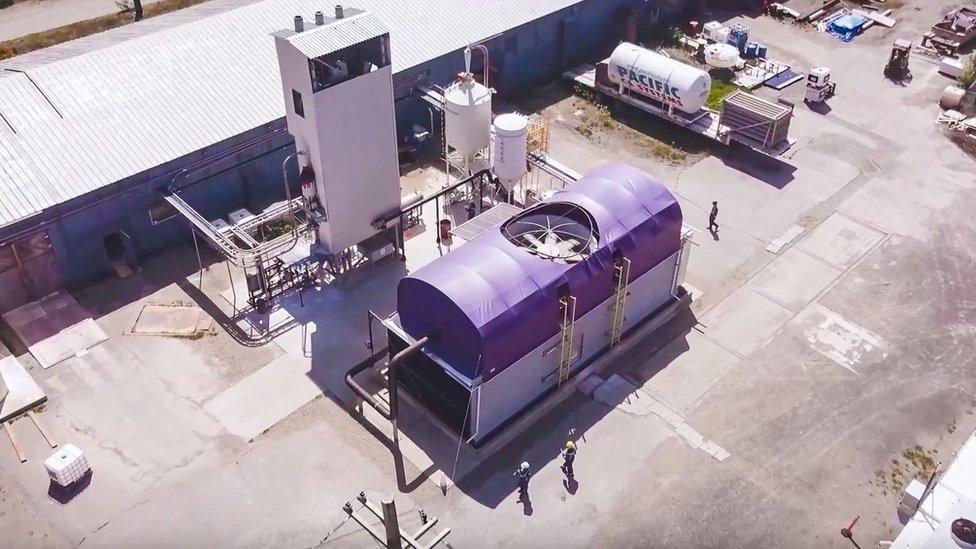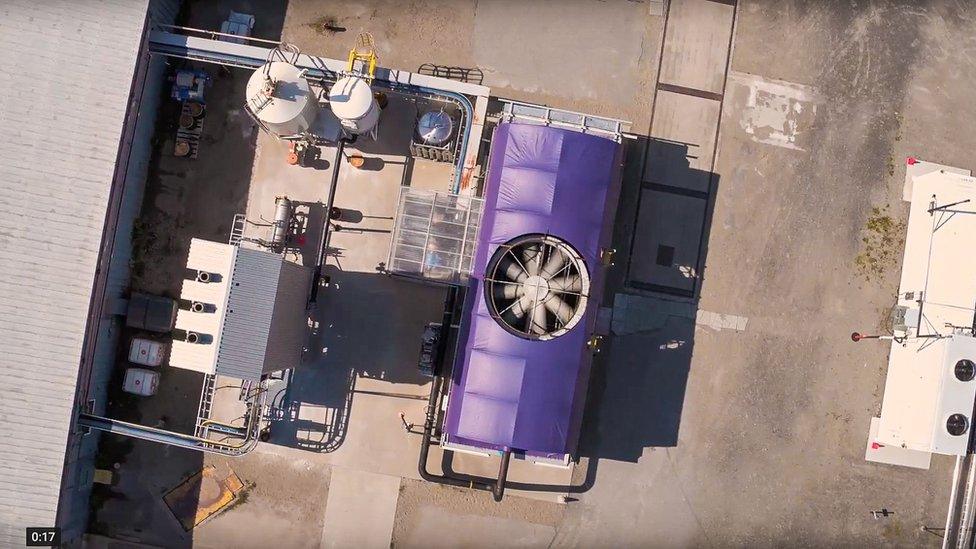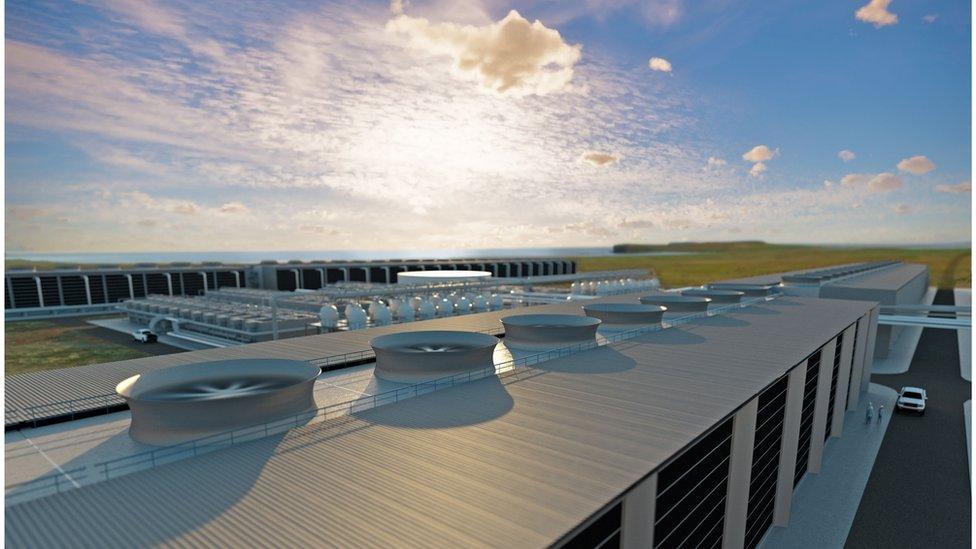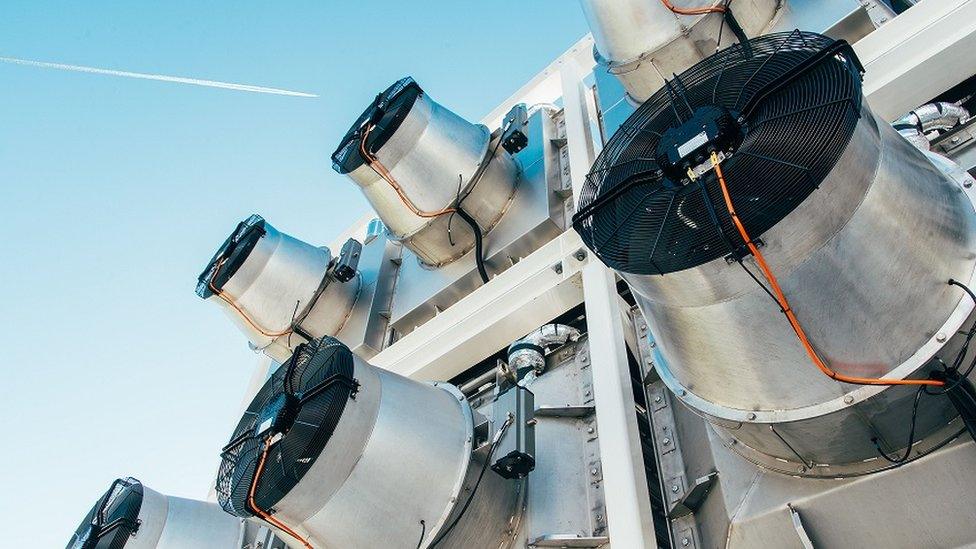Climate change: Large-scale CO2 removal facility set for Scotland
- Published
- comments

Carbon Engineering's pilot plant in British Columbia
A large facility capable of extracting significant amounts of carbon dioxide from the air is being planned for north east Scotland.
The proposed plant would remove up to one million tonnes of CO2 every year - the same amount taken up by around 40 million trees.
The extracted gas could be stored permanently deep under the seabed off the Scottish coast.
But critics argue that technology isn't a magic bullet for climate change.
What's the plan?
This Direct Air Capture (DAC) plan is a joint project between UK firm Storegga, external and Canadian company Carbon Engineering, external.
It's at a very early stage of development - today's announcement is the beginning of the engineering and design of the plant.
A feasibility study has already been carried out and if everything goes well, the facility would be operational by 2026.
Storegga say up to 300 jobs would be created in the construction phase.
However there are many hurdles, including planning and finance - and a site for the plant won't be selected until next year.
If it does go ahead it would be the biggest DAC facility in Europe and depending on the final configuration, could be the biggest in the world.
Why is this facility needed?
According to the Intergovernmental Panel on Climate Change, external (IPCC), if the world wants to stay safe, then the rise in global temperatures needs to be kept below 1.5C by the end of this century.
There's not much wiggle room left: in 2020 temperatures were already 1.2C above the historical level.
To keep the mercury down, we need to curb the emissions of the warming gases that are driving them up.

A giant fan sucks in air which is then exposed to a chemical solution to capture the CO2
The IPCC says that rapid cuts in carbon from cars, home heating and almost every aspect of our lives will be needed over the next decade.
Even then, say the scientists, the world will still need to suck significant amounts of greenhouse gases out of the atmosphere to stay below the 1.5C threshold.
While planting trees is one important approach to this problem, technology is also being used to capture CO2 directly from the air.
"Even if all the other measures that we're taking to avoid emissions, electric cars, renewable energy, those types of things, even if those succeed, you still need carbon removal," said Steve Oldham, CEO of Carbon Engineering.
"Direct air capture I think is going to be a significant part of the UK is net zero plan."
"For us a typical facility is about a million tonnes of CO2 removal per year. That's the equivalent of 40 million trees."
How would the proposed plant work?
Canadian company Carbon Engineering is one of the leaders in this field.
At their pilot plant in Squamish, British Columbia, they've been removing CO2 from the atmosphere since 2015, pulling down around 1 tonne of CO2 every day.
Their system involves a fan to suck in air, which is then exposed to a liquid mixture that binds the carbon dioxide.
Through further refinement, the liquid is turned into calcium carbonate pellets.
The BBC's Matt McGrath explains how one company is removing CO2 from our air
When these are treated at temperature of about 900C, the pellets decompose into a CO2 stream and calcium oxide.
That stream of pure CO2 is cleaned up to remove water impurities.
At that point it can be pumped underground and buried permanently, sold for commercial use or even turned into liquid fuel.
Right now the plan is for Carbon Engineering licence their technology to UK firm Storegga, who will be responsible for choosing the site and building the facility.
Why Scotland?
According to both companies involved, north east Scotland has significant advantages for this type of technology.

This is what a large scale air capture facility might look like
They point to the fact that there is abundant renewable energy sources, there's a skilled workforce from the North Sea oil industry that have the type of skills needed to build and operate a DAC facility.
But a key advantage are pipelines going out under the sea to allow the permanent burial of the captured carbon.
"We're keen to locate the plant as close as possible to transport and storage infrastructure so we don't actually have to suffer more and more costs to move captured carbon offshore and then underground," said Alan James from Storegga.
Are fossil fuel companies involved in this process?
Carbon Engineering has received significant investment from fossil fuel companies in the past and is working closely with one firm on the development of a DAC plant in Texas.
Oil companies are keen on good quality CO2 because they can use it to flush out extra oil from depleted wells.
That's not the plan for Scotland according Alan James from developers Storegga.
"I came out of the oil industry in 2007, largely because I was getting concerned about what the impact was," he told BBC News.
"None of the emissions that we take out here will be used for extracting more hydrocarbons. That's not what our business now is about. We have nothing to do with producing hydrocarbons, period."
Are there concerns about this type of technology?
Scientists say that DAC, if deployed widely, will have major impacts on energy, water and land use.
By 2050, according to this report from last year, external, food crop prices could rise more than five-fold in some parts of the world.
Some people are also worried that if direct air capture becomes economically viable, then governments might start to go easy on cutting emissions.

Other companies are working on alternative approaches to removing CO2, including Climeworks in Switzerland
However, supporters of DAC say that's not the case - they argue that for sectors that are hard to cut, including shipping, aviation and the oil and gas industry, then DAC is a good option for limiting their impact on the climate.
Researchers who've studied these emerging technologies say it would be foolish to rely fully on them and neglect the basic steps of decarbonising power, transport and industry.
"It's a much more sensible strategy to treat these technologies as a really nice addition, we should work hard on them and make sure that they can become cost competitive, and economic in the 2020s," said Dr Ajay Gambhir, a senior research fellow at the Grantham Institute for Climate Change and the Environment.
"But at the same time, we need to just make sure we reduce emissions as fast as possible as far as possible. So that if DAC does come along, then then that's great. That's a really nice addition to our toolkit if you like, but we definitely don't rely on them."
Follow Matt on Twitter., external